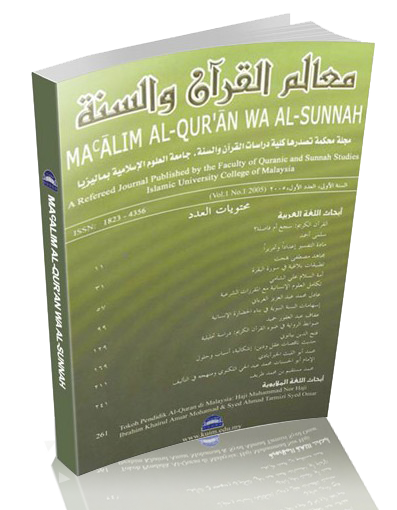Pengajaran Kursus Ulum Hadith di Institusi Pengajian Tinggi Awam: Tinjauan Literasi Terhadap Pendekatan Pengajaran Masa Kini
Teaching the Science of Hadith Transmission Course in Public Higher Educational Institutions: A Literacy Review of Current Teaching Approaches
DOI:
https://doi.org/10.33102/jmqs.v13i14.100Abstract
Hadith is the second source of Islamic law. Learning Hadith is important because it is the knowledge that plays a role in preserving the purity of the hadith applied in life. Therefore, this article is to study the teaching approaches that can be applied to the Ulum Hadith subjects offered at higher education institutions in Malaysia and identifying opportunities to reinforce the Ulum Hadith teaching approach. This study uses document analysis and articles related to education, Islamic Studies, as well as approaches in teaching. The findings show that among the approaches in the teaching and learning of the Ulum Hadith subjects in higher learning institutions are lecturers should act as muallim, producing meaningful learning with student-centered teaching, using an eclectic approach that combines all or part of the features of a method into new methods, using tables and diagrams in learning, mastering the four pedagogical skills of the Prophet, and implementing active learning. The study is expected to help improve Ulum Hadith’s teaching system at Malaysian institutions of higher learning.
References
Al-Qur’anal-Karim.
Ab. Halim Tamuri & Mohamad Khairul Azman Ajuhary. (2010) Amalan Pengajaran Guru Pendidikan Islam Berteraskan Konsep Muallim. Journal of Islamic and Arabic Education.
Ashraf M. Zedan et al., (2014). An Innovative Teaching Method in Islamic Studies: The Use of Powerpoint in University Of Malaya as Case Study. Procedia - Social and Behavioral Science.
Ayla Göl. (2011). Constructing Knowledge: An Effective Use Of Educational Technology For Teaching Islamic Studies In The UK. Educ Inf Technol.
Hasnuddin Bin Ab Rahman et al., (2015). Keberkesanan Penggunaan ICT Di Dalam Pengajaran Dan Pembelajaran Pendidikan Islam Bagi Sekolah Kebangsaan Desa Pandan Kuala Lumpur. Proceeding of International Conference On Information Technology & Society.
Mohd. Muhiden Abd. Rahman. (1996). Al-Hadith: Kedudukan Dan Peranannya. Jurnal Usuluddin.
Mok Soon Sang, (2008). Pedagogi Untuk Pengajaran Dan Pembelajaran. Selangor: Penerbitan Multimedia.
Muhamad Faisal Ashaari et al., (2012). An Assessment of Teaching and Learning Methodolgy in Islamic Studies. Jurnal Pendidikan 59.
Najm Abd. Rahman Khalaf et al., (2014). Al-Madkhal Ila Ulum Al-Hadith. Selangor: Darul Syakir Enterprise.
Noor Hisham Md Nawi. (2011). Pengajaran Dan Pembelajaran: Penelitian Semula Konsep-Konsep Asas Menurut Perspektif Gagasan Islamisasi Moden. Kongres Pengajaran Dan Pembelajaran UKM.
Noornajihan Jaafar & Ab. Halim Tamuri. (2012). Pedagogi Rasulullah SAW Dalam Pengajaran. Prosidng Seminar Penyelidikan Institut Pendidikan Guru.
Qutrennada Rosli & Ahmad Yunus Mohd Noor. (2015). Pengajaran Dan Pembelajaran Hadith di Maahad Darul Hadis, Alor Setar, Kedah: Tinjauan Awal. Prosiding Kolokium Antarabangsa Siswazah Pengajian Islam (KASPI).
Siti Muhibah Hj Nor & Ab. Halim Tamuri. (2015). Prinsip Pembelajaran Aktif Dalam Pengajaran Dan Pembelajaran Pendidikan Islam. Jurnal Pendidikan Fakulti Pendidikan.
Tengku Sarina Aini Tengku Kasim & Faridah Binti Che Husain. (2008). Pendekatan Individu Dalam Pengajaran Pendidikan Islam Sebagai Wahana Melahirkan Modal Insan Bertamadun. Jurnal Usuluddin.
Thuraya Ahmad & Fauzi Deraman. (2011). Penggunaan Jadual Dan Gambarajah Di Dalam Penulisan Bagi Kursus Mustalah Al-Hadith. Jurnal Al-Quran Dan Al-Hadith: Seminar Antarabangsa Sunnah Nabawiyah: Realiti Dan Cabaran Semasa (MUSNAD).
Wan Ahmad Jaafar & Wan Yahaya Rosli Abd Rahman. (2008). Pembudayaan Penggunaan Teknologi Dalam Pengajaran Dan Pembelajaran Dalam Kalangan Guru Pendidikan Islam. Diges Pendidik.
Downloads
Published
How to Cite
Issue
Section
License
Copyright (c) 2017 Shumsudin Yabi, Syulhanif Kadri, Zulhilmi Mohd Nor, Mohd Fauzi Mohd Amin

This work is licensed under a Creative Commons Attribution 4.0 International License.
The copyright of this article will be vested to author(s) and granted the journal right of first publication with the work simultaneously licensed under the Creative Commons Attribution 4.0 International (CC BY 4.0) license, unless otherwise stated.
Authors are able to enter into separate, additional contractual arrangements for the non-exclusive distribution of the journal's published version of the work (e.g., post it to an institutional repository or publish it in a book), with an acknowledgement of its initial publication in this journal.
Authors are permitted and encouraged to post their work online (e.g., in institutional repositories or on their website) prior to and during the submission process, as it can lead to productive exchanges, as well as earlier and greater citation of published work.









